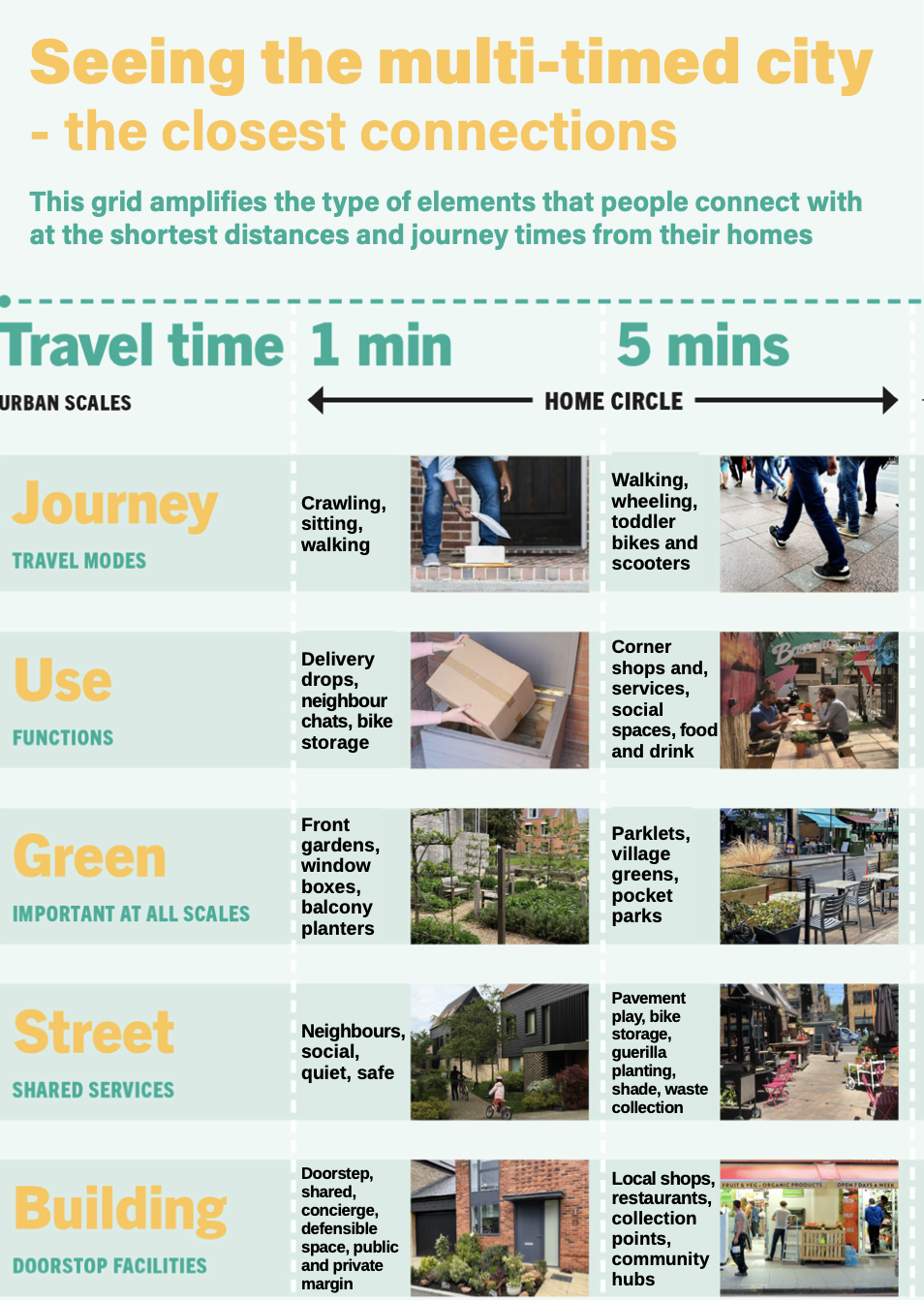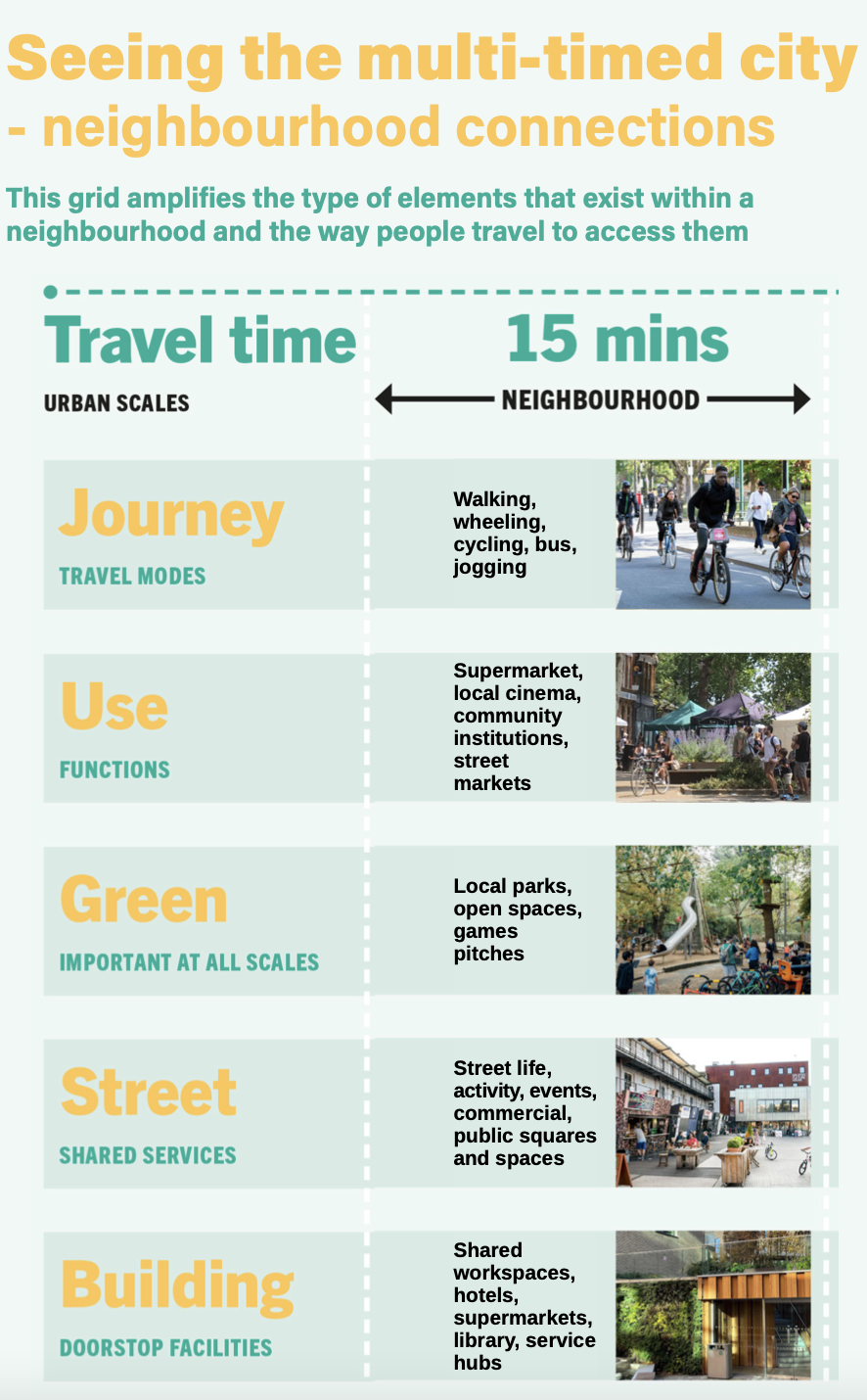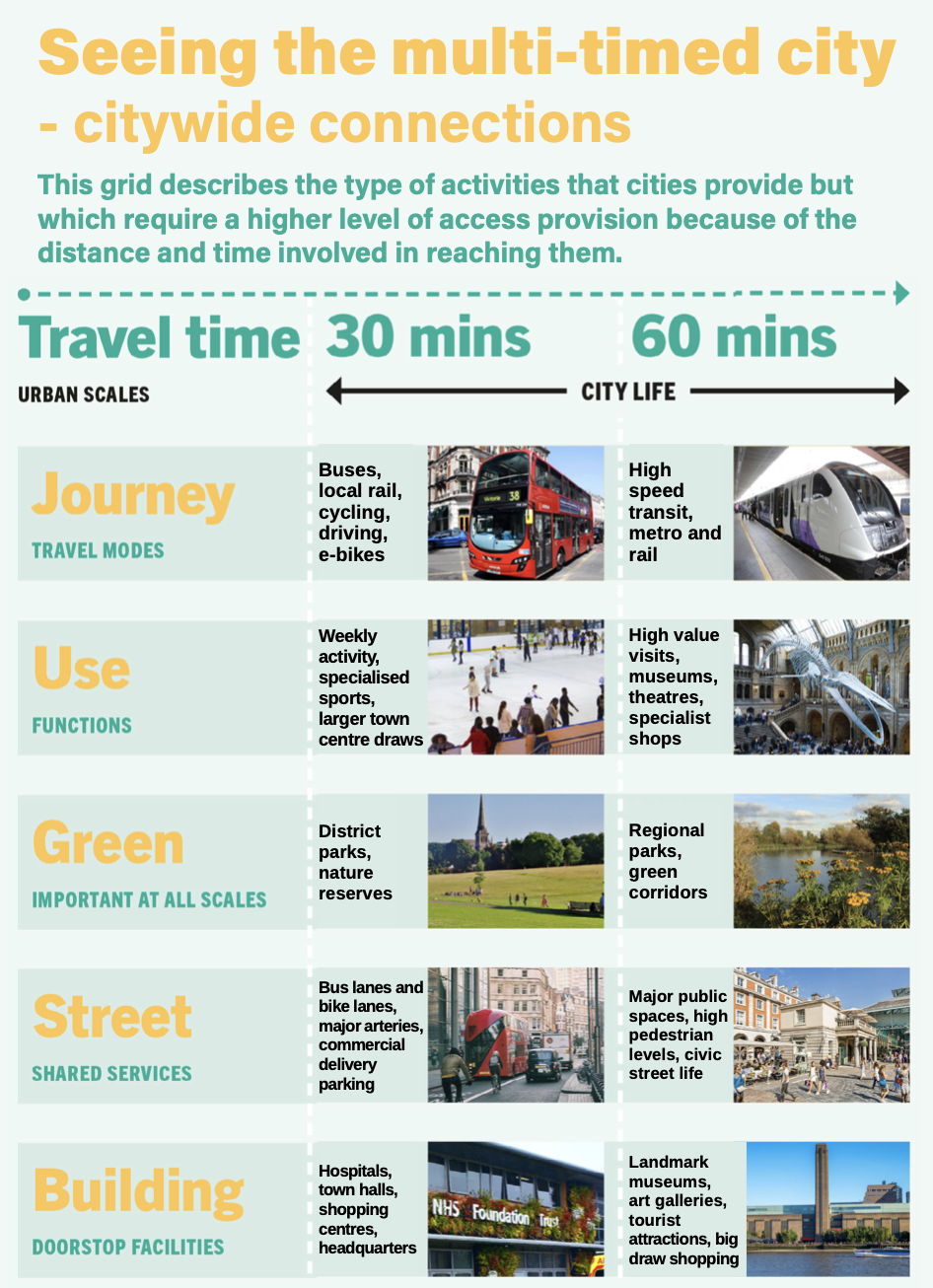TAPAS.network | 14 November 2022 | Commentary | Esther Kurland
Thinking beyond 15 minutes: we need a whole new perspective on space, time and travel to deliver better places to live

The concept of the 15 minute city has caught the imagination of both urban and transport planners in recent years. Though welcomes it, she sees the case for a multi-timed city, which balances the importance and function of different types of journeys that take time spans from one minute to one hour. Establishing policies that recognise the hierarchy of these distinctive elements will help meet environmental, social and economic goals, she believes.

THE CONCEPT of the 15 minute city has caught the imagination of both urban and transport planners in recent years. Though Esther Kurland welcomes it, she sees the case for a multi-timed city, which balances the importance and function of different types of journeys that take time spans from one minute to one hour. Establishing policies that recognise the hierarchy of these distinctive elements will help meet environmental, social and economic goals, she believes.
We have heard a lot recently about the 15 minute city, or rather individual neighbourhood elements of it. It is a great idea, calling for people to live within walking distance of the facilities they need day to day. The concept helps to reduce dependence on motorised transport, and address the exclusion that brings for those who cannot use such modes. It is also a counter for the dangerous idea that it is fine to continually raise residential densities without providing all the things that make life worthwhile and productive. Requiring 15 minute neighbourhoods can help ensure we do not increase car dependency and isolation through housing growth.
But even the most complete neighbourhoods cannot successfully exist in isolation, and 15 minutes is not the only time frame we need to keep in mind. At Urban Design London we recently ran an Urban Challenge project looking at how policies and approaches across the transport, planning, housing and architecture sectors all needed to change to meet shared objectives for the future.
Within this work we developed the idea of ‘the multi-timed city’, recognising the importance of spaces and facilities at various distances from homes, and the need to manage the interplay between these.
The multi-timed city is an idea to help ensure the places we plan, design, build and manage can effectively support environmental, social, health and economic objectives. That is, that they facilitate resource - responsible lifestyles and economies, community cohesion and the health and wellbeing of everyone. The Urban Challenge project concluded by calling for policy across all built environment sectors to aim for some core outcomes:
-
Less miles travelled, but not less journeys
-
More flexible and adaptable buildings where the impact of uses, not their existence, is managed
-
Local living, encompassing the 15 min neighbourhood concept
-
Polycentric cities with all areas reaching, but not exceeding, their natural carrying capacity for economic activity.
These four objectives need each other for an overall benefit to arise. None can be successfully delivered without the other three. We cannot achieve less miles travelled unless we have more complete neighbourhoods, for example. We cannot bring neighbourhoods to life without more flexibility in how buildings are used.
Moreover, without rebalancing activity levels across cities, and reducing the dominance of central business districts and activity zones, local high streets and economically active neighbourhoods elsewhere will struggle. Meanwhile, going back full circle, we cannot achieve less miles travelled without reducing the need for commuting within monocentric urban structures. The multi-timed city concept helps us draw these objectives together.

Starting with the 1 minute city, we need to make sure entrances to homes, and the public and shared spaces immediately around them, work well. This is generally down to architects, developers and planners, but can have a significant impact on public safety, and travel and economic behaviours. Good urban design tells us that front doors should be easy to see, get to and use. Front doors and the windows around them should create eyes and activity for the street and buffer zones such as front gardens between internal private space and public street life, are important too. These issues are included within national planning design guidance now.
However, we deal less well with the increasing need for home deliveries for domestic or work purposes, customers visiting home/work environments, the need to manage and store waste responsibly, and the need to ensure active travel options are the closest and easiest to use. All such requirements should be designed into the 1 minute city, whatever the home and building types, if we are to meet the challenges we face.


Moving to the 5 minute city, this can also sometimes be called ‘neighbour space’ and is vital for community cohesion and our sense of belonging. Within 5 minutes of our front doors are the spaces we share with a few neighbours, whether it be a lobby in a block of flats, or the bit of street in front of ten or so houses. These are the spaces we are likely to be using every day, maybe multiple times. This is also the area where active travel and shared mobility facilities can be placed front and centre. But also, doorstep play, shared delivery and storage facilities and amenity space should also be made available.
Access to nature, comfortable microclimates and natural climate resilience measures, such as sustainable urban drainage, should form other parts of this 5 minute city. Some have called for everyone to see a tree, or planted bed of growing things, from their home. What a wonderful idea - and how good this would be for biodiversity, reducing urban overheating and for mental health and wellbeing. Achieving it means greening the 5 minute city.
Neighbour space is particularly important in higher density areas, where outdoor shared living is an important part of life. Ideally, neighbour spaces should be very flexible, allowing neighbours to mould them to their needs. For example, shared bike storage at this scale, rather than massive impersonal underground bike rooms, may be more appealing. But if people want to store prams instead of bikes, or shared BBQs and garden equipment, the storage areas should be designed to allow for this, so all space is used to its optimum.
Keeping in mind the need for more flexible use of buildings, allowing some home working activities to spill into neighbourhood spaces could be beneficial. This might be ad hoc seating for a home-run food business, space to manage commercial deliveries appropriately, or just the opportunity to advertise what is on offer. Of course, robust management systems would be needed, built into new developments from the start, and retrofitted into existing areas through neighbourly co-operation where this is feasible.
Providing good neighbour spaces could potentially reduce overall site residential densities. But I suggest it would be worth it, helping to ensure all space is used to its optimum, and that the home environment goes beyond the space behind the front door.

I will not say too much about the 15 minute city, or complete neighbourhood, as so much has been written about this already elsewhere. Suffice to say it should provide everything people need from one day to the next within a 15 minute easy walk. This should be measured as the foot falls, not as the crow flies, and should not include routes that are difficult or unsafe to use.
It can be useful to aim for three things when looking to create complete neighbourhoods. First see if there are ways to make it physically bigger through increasing or improving walking routes. Simply unlocking a park gate or fixing the lights under a bridge might help do this.
Second, look to get more people and activities into the catchment area. This could be through planning briefs/codes or site assembly work to encourage new housing or other development. Or it could be through supporting more flexible, possibly temporary, activity in underused buildings and spaces.
Lastly, we should look to make the neighbourhood more attractive, developing its unique identity, character and relevance for the local community. Making activities inside buildings more visible will help. We would probably all be amazed at how much hair dressing, cake baking, tutoring, chiropody, curtain making, exercise sessions etc go on down what appears to be a quiet residential street. If we knew what things like this we could access within 15 minutes of home, we might not need to travel so far.

Of course, none of this is easy, and retrofitting complete neighbourhoods into existing mono use suburbs or similar is a hard task. But if we don’t pull together across all built environment sectors and aim for the same outcomes, we will never get there.

The 30 minute neighbourhood rarely gets talked about. For many it is the town centre, a place with facilities that need a larger catchment than the 15 minute neighbourhood. We might be happy to travel half an hour to a swimming pool once a week, or a larger park for a long dog walk. Going to the pub with the Abba tribute band (I am showing my age) or a larger skate park or for comparison shopping.
Public transport is key for the 30 minute city, particularly buses, or future forms of demand- responsive shared mobility. Service and mobility hubs should be provided to support appropriate access and ensure people do not feel compelled to drive because it is just such a pain to get to and back again with shopping if you don’t.
The quality of public space, buildings and the activities they house need to make the 30 minute journey worthwhile, particularly as many of us can now shop for just about anything online. So the experience we have is key to success at this scale. It isn’t like neighbour spaces that we just have to go through if we leave home – people make a conscious effort to travel this kind of distance, and the destination has to be worth it.

Improvements to high street environments, introduction of walking loops taking in a variety of key destinations, and the downgrading of car dominance are all important. There is an economic chicken and egg issue here – if you reduce car accessibility you might reduce viability of commercial offers (according to those businesses) but if you don’t do this, how can you grow and improve the attractiveness to draw people this distance from home?

The 60 minute city is the last metric I will mention. It is vital to success at all the other scales, and it should be the icing on the cake. It represents accessing the big ticket draws, the things people will happily travel for an hour to reach. Those such as major museums, concert venues, specialist shopping areas, the trendiest nightclubs or historic attractions. Ideally, these should attract lots and lots of people, but they should each not need to use them very often. Train travel is perfect to connect up this kind of catchment area, and the attractions have traditionally tended to be clustered around major stations.
The traditional 60 minute city is also historically designed around commuting, with people traveling long distances day in, day out, to reach central business districts. This model has helped pay for shared mobility infrastructure, in particular trains and metros in some cities, but Covid-19 showed us that the basic model is inefficient and may even now be busted.
The use of longer-distance shared mobility services for occasional work trips, but more often nowadays leisure trips, may be more likely than major fixed track investment to help cities meet future challenges and ensure efficient use of transport infrastructure.
Demand patterns are changing. In London, in February 2022, overall tube ridership was 60% of pre-pandemic levels, but weekend rates, likely for leisure and entertainment more than office work, were around 75% (see the link).
Against this background of changing behaviour and lifestyle objectives, establishing policies and approaches that strive to create a multi-timed city will help meet environmental, social and economic goals. It will help ensure an efficient use of all land and transport resource, and support people in leading healthier and less stressed lives by making travel opportunities fit better with the locations of the places they want to get to - and how often they want to use the facilities there. Removing unnecessary, tiring and resource- hungry commuting, whilst filling the travel space this leaves for high value trips, done less often by more people, will be a win-win for everyone. And alongside this supporting the shorter trips done by less people, but more often, as active rather than car-based travel modes. But all this cannot happen through transport policies alone. It needs the collaboration of all built environment sectors and processes, working in close step, based on a shared understanding of the benefits of an holistic, multi-timed city approach.
Esther Kurland is designer at Urban Design London and describes herself as a town planner with an urban design bent. She worked in development management and design and conservation roles for 10 years in District and Borough councils before joining the Greater London Authority to develop the urban design and built environment policies for the first London plan. She later led on planning work at CABE (Commission for Architecture and the Built Environment) before leaving to develop Urban Design London’s training and support programme over the last 14 years.
Esther has been a panel member and chair of a number of design review panels include at CABE, the GLA and a range of local authorities. She is also an advisor on the built environment to NICE and has been an external examiner for UCL planning courses for the last 4 years. She is a non executive director of the National Planning Forum and is a member of CHITs Urban Design Panel.
This article was first published in LTT magazine, LTT857, 14 November 2022.
You are currently viewing this page as TAPAS Taster user.
To read and make comments on this article you need to register for free as TAPAS Select user and log in.

Log in